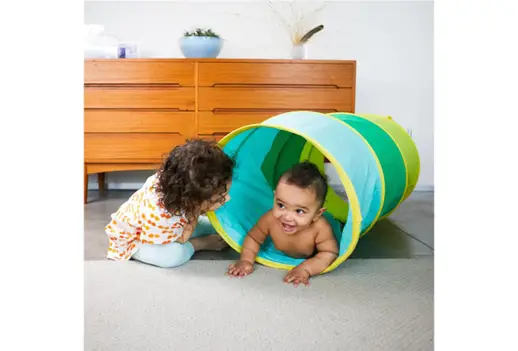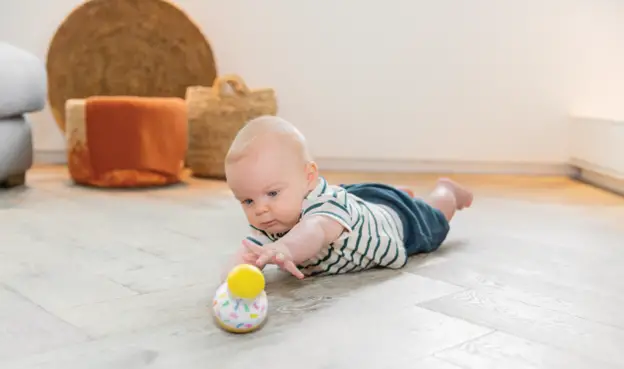Are you eager to learn how to teach baby to crawl and help your little one master this important skill?
Here is the guide you need! I will cover everything relevant to a crawling baby, including different crawling styles, helpful tips, signs baby is ready to crawl, and more!
I will also teach you how to ensure the space around the baby is safe so you can enjoy every moment with your little angel.
But first, let’s see at what age are babies ready to move independently!
When Do Babies Learn to Crawl?
If you wonder when do babies typically start crawling, the answer might surprise you. Some babies start crawling as early as six months of age, and some make crawling movements once they reach one year.
There isn’t a textbook rule when your baby crawling stage should begin. For example, don’t worry about your 9 month old not crawling. Your baby might need more time. Also, some babies skip crawling altogether, and it is perfectly normal.
Further reading: Baby Walking Before Crawling
Before you learn how to help baby crawl, here are some signs the baby is ready for crawling practice!
Holding and Grasping Things
Babies hold onto things and grab objects around themselves as part of their environment exploration. Doing so helps them move safely.
Rocking
Rocking back and forth requires special motor skills and whole body muscles. If the baby can do this, chances are, they are ready to crawl!
Pulling the Body Up
If you notice your baby pulling the upper body up from a sitting position and holding on to the coffee table or other objects, it means they are getting closer to the first steps or crawling.
Getting on All Four
When your kid starts lifting its body weight on hands and knees, it is a safe sign that your baby is ready for the crawling milestone.
Just standing on hands and knees require upper body strength, balance, and coordination, important skills for independent movements.
Feet Movement
Before you start teaching baby to crawl, check how well they can move their feet and legs while holding toys or sitting. It increases their coordination skills and helps their legs become stronger.
Crawling Styles and Stages
There are several ways babies crawl, all perfectly normal.
Also, some babies may improve their skills, and master different crawling styles in a couple of days, while others need more time. Most babies crawl on their hands and knees, but it is only one of the many styles out there.
Let’s talk about additional ways babies can move from point A to point B.

Commando Crawl
Commando crawl is typically the first crawling-like movement your baby will make. When the baby is on its tummy, it will push its arms to move forward without lifting the legs. Most babies overgrow the command crawl style as they learn to use their legs and entire body equally.
Backward Crawl
Parents may notice their babies crawl backward if they feel their babies have stronger arms than legs.
In reality, many babies begin crawling phase by pushing their bodies backward. Some babies will move on to walking, and others will eventually start crawling forward as their legs get stronger.
Classic Crawl
Classic crawl is what you probably think of when someone mentions crawling. It is a position where the baby is on its hands and knees and moves forward by shifting weight from one arm to its opposite leg and repeating the movement as they move forward.
Classic crawling seems simple, but for babies, it includes a lot of skills and strength.
Crab Crawl
Crab crawling differs from classic crawling because a baby doesn’t keep its knees on the floor. Instead, the knees are above the ground, and a baby distributes all weight to its arms and feet.
Also Read: How To Correct Asymmetrical Crawling: Tips And Techniques

Scoot Crawl
Some kids never learn to move on their arms and knees. Instead, they only scoot around! Scooting happens from a sitting position.
It’s when they baby sits on the floor and moves around using only its legs and tushy! Some babies will lift their bodies upwards and learn to walk from this point, and others will lean forward and start crawling.
9 Tips to Teach Baby to Crawl

Are you wondering how to encourage crawling? Here are some specific tips to help your baby move!
Encourage Tummy Time
Tummy time is important for your baby’s development and not only for crawling. It helps the baby to get stronger and makes the arm movements necessary for crawling.
When you put the baby on its tummy, you can place objects around it to help get its attention. So, using toys that encourage crawling will motivate the baby to move towards them and learn to crawl with the right movements.
Related: When to Start Tummy Time
If your baby hates spending time on the tummy on the floor, try doing so on your chest or any other tummy time alternatives.
Use a Tunnel
Tunnels are a great way to encourage independent movement. It will spark the need for independent movement in babies. Aim for tunnels made from comfortable and breathable materials, such as the Lovevery The Organic Cotton Play Tunnel.
Tunnels are safe environments for babies to increase their strength and learn to crawl.

Reduce Baby Walker and Bouncer Usage
Babies who spend a lot of time in walkers or bouncers might learn to crawl later. Baby walkers and bouncers are great for temporary baby calming, but these things don’t help the baby develop new skills or get stronger.
Walkers allow the baby to move faster than it is ready to move in space. Some products even pose the risk of causing unwanted injuries.
Instead, use baby crawl toys such as colorful rings and rollers to encourage crawling.
Use Your Palms
When your baby is on the tummy, place your palms against the baby’s feet. It will help the baby push against your palms and move forward. The more the baby repeats this movement, the sooner they will get stronger and be ready for crawling.
Give Your Baby a Little Boost
Sometimes the baby needs you to lift it up on its knees to crawl. When the baby is on their tummy, help it stand on all four. Hold them until they are strong enough to stay like that and move forward.

Offer a Comfortable Space for Exploration
Keeping the baby safe and comfortable during first crawling movements is essential for its progress. When the baby has positive associations with tummy time and belly crawl, they will be more likely to explore the environment and crawl!
Place Objects Just Out of Reach
Another great way how to help baby crawl is to use toys and visually appealing objects to motivate the infant to move towards them.
Place the baby on its tummy, maybe lift its body with your hands, and put its favorite playtime toy out of reach. Hopefully, the toy will trigger some movements!

Get on Their Level
Lie next to your baby and lend a helping hand from the baby’s perspective. You can put your hands underneath the baby’s belly or support it in other ways by moving its legs and arm.
When you are down with the baby, it is easier to see when the baby needs help and what skills they need to develop.
Use Your Own Hands for Guidance
If your baby crawls backward or sideways, you can guide it forward with your hands. Babies who master crawling in one way are strong enough to crawl forward, but they might need a little help.
How to Keep Moving Babies Safe?
The safety of your baby during crawling is a priority for all parents. You can do a few things to keep the baby safe when it starts to move independently.
- Move Furniture – A baby needs enough space to crawl, so keep furniture to a minimum. The coffee table is okay, as long as there aren’t sharp edges and the baby cannot tip it over!
- Eliminate Cleaning Detergents From The Floor – Keep the bathroom door closed and move everything from the floor, including cleaning products.
- Reduce Cables and Cords – If any cables and cords are lying on the floor or present in the kitchen, move them outside the baby’s reach.
- Cover Electrical Outlets – When childproofing your home, don’t forget electrical outlets!
- Secure The Stairs – Install a safety gate on the top and bottom of your stairs to prevent your crawling baby from falling on the stairs.
- Keep Plants Away – Some plants contain toxins, so keeping them away from your crawling baby will ensure both the baby and the plants remain safe!
- Keeping The Doors Closed – Install security knobs in the bathroom and kitchen to prevent your baby from going into rooms you haven’t childproofed!
Further Reading: Baby Proofing Checklist
Final Thoughts
Being there for your baby is a wonderful experience that requires your full attention, and perhaps assistance. The crawling milestone is a noteworthy and fun one, whether your baby learns to crawl in a standard or any alternative way!
I hope you find this guide useful! Don’t hesitate to ask questions, I will be happy to help! Also, if you have more tips, share them with us!
–




